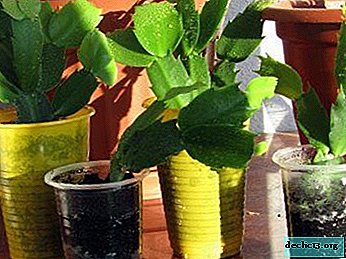Foreign beauty Thai orchid - photos, plant selection and care secrets

Everyone can replenish their home flower garden with a Thai orchid. And although the export of these flowers outside the country is considered smuggling and prosecuted by the law, the Thais have found a way to transport orchids across the border quite legally.
For sale, the sprouts of the flower are previously placed in a bottle - a flag, which is hermetically sealed. The flower is stored in a special gel called agar agar. You can buy this souvenir in the Duty Free shop, any Thai orchid farm, or order it online.
Where to order and how much?
You can order an orchid in the online store or at individuals who import flowers in small batches. The number of seedlings in each flask varies greatly (from 10-15 to 40). The approximate price of a flower in a bottle in an online store is from 2.5 thousand rubles. up to 20 thousand rubles For private individuals, it may be negotiable.
The only difference is that in the online store you can even buy one bottle with a flower from Thailand, but private traders have a condition: either buy out a whole batch (5, 20-30 pcs.), Or wait for the right number of buyers to collect.
How to choose the right one?
 You can determine which plant variety was placed in the bottle by the label glued on it. But not all orchids are designed for growth in such conditions, and this must first be relied upon when choosing a flower. Experts give good forecasts for growing from a state of a sprout to an adult plant in:
You can determine which plant variety was placed in the bottle by the label glued on it. But not all orchids are designed for growth in such conditions, and this must first be relied upon when choosing a flower. Experts give good forecasts for growing from a state of a sprout to an adult plant in:
- phalaenopsis;
- vand;
- oncidiums;
- dendro-phalaenopsis;
- cattleya.
Another important criterion is the speed of cultivation. Phalaenopsis seedlings will begin to bloom in a couple of years. But the flowering of Cattleya or Wanda will have to wait from 5 to 7 years, and in some cases as much as 10. Hybrids can be called the most stable, they can grow to the state of a flower and please the happy owner every year with their flowering.
What does the market offer?
In Thailand, orchids are cultivated not only by specialized nurseries, but also by individual farmers. At the same time, a unique variety can be grown on each farm that is not found anywhere else.
Interesting: The peculiarity of orchids from Thailand lies in the fact that a large number of hybrids are found on the market, because orchids cross easily. For example, the well-known "vanda" is nothing but a hybrid of two species - ascocentrum and renanteres.Types and photos of a flower
Below you can find a description of the types of orchids and see their photos.
Phalaenopsis
The most numerous of them. Delicate, fragrant flower, somewhat reminiscent of soaring butterflies.

Cattleya
Another popular species, named after its pioneer English botanist William Cattley.

Rhinostilis gigantea
The largest representative among orchids, it has a huge number of shades: from white to purple.

When do you need to extract a plant immediately from a bottle, and when not?
If you receive a flag with orchids, carefully inspect it. The state of the seedlings will determine when to open the flask.- If the bottle is not damaged, and the plant has enough nutrient solution - the flower should be allowed to rest for 2-3 weeks from the stress experienced. The sealed flask should be placed in the correct environment with warm, moist air, without drafts and hypothermia. Two weeks later, as soon as the growth of seedlings is noticeable, they should be carefully removed.
- It will be necessary to open the flask immediately only if it has damage, or the special solution has ended. You can find out by the first signs of deterioration of the root system.
Transfer
It is time to transplant an orchid. Here you need to follow a few simple steps so that the flower takes root:
- It is necessary to carefully release the seedlings from the bottle, special care should be taken with the roots - they are very fragile.
- Rinse and dry the roots.
- Plant seedlings in another substrate. To do this, you can take small bark.
- Without a sealed bulb in a normal environment, the flower will not last long due to a weak root system. First of all, you need to strengthen the roots. To do this, place orchids in a special greenhouse on a moist, pre-disinfected moss. A transparent container can be used as a greenhouse, which should be covered with glass. Thus, we simulate the conditions of the tropics.
- Condensation on the glass and the vessel must be wiped daily, and the improvised greenhouse should be ventilated to prevent the process of decay. Orchids will very quickly acquire real roots and will be ready to plant in a pot. How to choose a pot for orchids read here.
You will find all the nuances of planting seeds, bulbs and orchid children in this material.
The nuances of care
 Depending on the type of flower, there are some nuances in the content. When growing phalaenopsis, the following conditions must be observed:
Depending on the type of flower, there are some nuances in the content. When growing phalaenopsis, the following conditions must be observed:
- It is better to choose a windowsill from the western, eastern, and northeastern sides and organize shading.
- The temperature regime is important. Flowering lasts longer in the presence of shade and temperature from 18 to 25 ° C. In winter and autumn, a short-term drop in temperature to 12 ° C is acceptable. An ordinary temperature of the content is from 15 to 25 ° C.
- Humidity should be at 40%. Excessive and low humidity should not be allowed. To increase humidity, you can put the flower on a tray with water.
- Watering - only after the substrate has completely dried.
Golden rules of feeding
It is recommended to feed the orchid through watering during the growth period. For this, Kemira Lux fertilizer is perfect.
Observing the basic rules of dressing, you can be sure that the Thai orchid will be durable:
- Fertilizing an orchid after transplantation is strictly prohibited.
- Do not fertilize diseased plants.
- In autumn and spring, orchids are fertilized once every two weeks, and in the summer and winter - once a month. Do not feed the plant at all during the flowering period.
Breeding
For breeding orchids, the division propagation method is most often used. It is as simple and easy as possible. The main thing is that the plant should be large and have four false bulbs, making sure this follows:
- Remove the plant from the pot without damaging the roots.
- Peel the roots off the ground and cut. Make sure that on each half 3 pseudobulbs are formed.
- Slices of the flower treated with charcoal.
- Plant in a pot with a substrate. Read about what soil is suitable for orchids, read here.
Bloom
 Under optimal temperature conditions, orchid bloom can last almost 6 months. There are times when an orchid "refuses" to bloom. The main reasons for this may be:
Under optimal temperature conditions, orchid bloom can last almost 6 months. There are times when an orchid "refuses" to bloom. The main reasons for this may be:
- temperature jumps;
- improper watering;
- violation of rest;
- lack of light.
Also, the orchid does not tolerate drafts, it can be susceptible to root diseases. Compliance with all conditions of the flower is the key to its timely flowering.
Disease prevention
It’s always better to prevent a disease than to deal with its consequences, therefore the prevention of orchid diseases is very important. Simple rules should be followed to avoid many problems:
- Handle leaves and roots carefully.
- Do not leave wet compost overnight (rotting is possible).
- Provide ventilation and moist air.
- Clean the substrate from rotten and infected leaves.
- When trimming and transplanting, sterilize the entire instrument, wash hands thoroughly.
- Always place a new flower in “quarantine” so as not to infect old flowers.
Buying a real Thai orchid without leaving the borders of our country is not easy. It can be bought either in a flash or from experienced gardeners who plant these wonderful flowers.
And let there be rumors about the finicky of the Thai orchid, with all the rules for caring for the flower, you can achieve good results.

















